
Laos, officially the Lao People's Democratic Republic (LPDR), is the only landlocked country in Southeast Asia. At the heart of the Indochinese Peninsula, Laos is bordered by Myanmar and China to the northwest, Vietnam to the east, Cambodia to the southeast, and Thailand to the west and southwest. Its capital and largest city is Vientiane.

Evidence of modern human presence in the northern and central highlands of Indochina, which constitute the territories of the modern Laotian nation-state, dates back to the Lower Paleolithic. These earliest human migrants are Australo-Melanesians—associated with the Hoabinhian culture—and have populated the highlands and the interior, less accessible regions of Laos and all of Southeast Asia to this day. The subsequent Austroasiatic and Austronesian marine migration waves affected landlocked Laos only marginally, and direct Chinese and Indian cultural contact had a greater impact on the country.
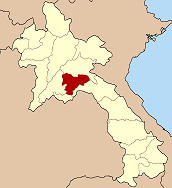
Xaisomboun was a special zone of Laos, located in the north of the country, near the capital Vientiane. The special zone was created 1994 by the military, with area split off from the provinces Vientiane and Xiangkhoang, in order to control and suppress the postwar Hmong resistance. It was officially dissolved on January 13, 2006, although the term continues to be used.
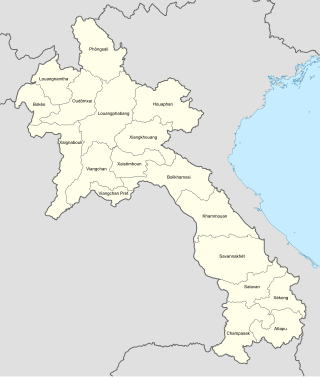
Laos, officially the Lao People's Democratic Republic, is divided into 17 provinces and one prefecture, the Vientiane capital city municipality. The special administrative zone, Xaisomboun, created in 1994, was dissolved on 13 January 2006. In 2013, parts of the former special administrative zone was reestablished as Xaisomboun province.
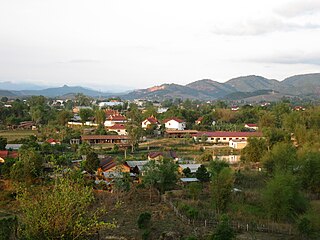
Phonsavan, population 37,507, is the capital of Xiangkhouang Province. Phonsavan was built in the late-1970s and replaced old Xiang Khouang, which was destroyed during the Second Indochina War.

Phou Bia is the highest mountain in Laos. It is in the Annamese Cordillera, at the southern limit of the Xiangkhoang Plateau in Xaisomboun Province. Owing to its elevation—2,819 m (9,249 ft), the highest terrestrial point in Laos, the climate is cold and the area around the mountain is mostly cloudy.
The insurgency in Laos is a low-intensity conflict between the Laotian government on one side and former members of the Secret Army, Laotian royalists, and rebels from the Hmong and lowland Lao ethnic minorities on the other. These groups have faced reprisals from the Lao People's Army and Vietnam People's Army for their support of the United States-led, anti-communist military campaigns in Laos during the Laotian Civil War, which the insurgency is an extension of itself. The North Vietnamese invaded Laos in 1958 and supported the communist Pathet Lao. The Vietnamese communists continued to support the Pathet Lao after the end of the Laotian Civil War and the establishment of the Lao People's Democratic Republic. At least 100,000 Hmong civilians were killed as the result of Laotian governmental policies, in what has sometimes been referred to as the Hmong genocide.

Bolikhamsai is a province of Laos. Pakxan, Thaphabat, Pakkading, Borikhane, Viengthong, and Khamkeut are its districts and Pakxan is its capital city. The province is the site of the Nam Theun 2 Dam, the country's largest hydroelectric project.

Vientiane province is a province of Laos in the country's northwest. As of 2015 the province had a population of 419,090. Vientiane province covers an area of 15,610 square kilometres (6,030 sq mi) composed of 11 districts. The principal towns are Vang Vieng and Muang Phôn-Hông.
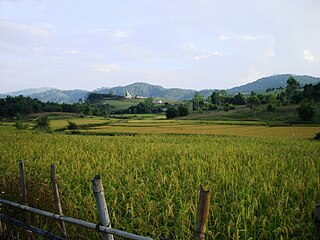
Xiangkhouang is a province of Laos on the Xiangkhoang Plateau, in the nation's northeast. The province has the distinction of being the most heavily-bombed place on Earth.

Savannakhet is a province of Laos. The name derives from Savanh Nakhone the province's original name. It bears the same meaning as Nakhon Sawan, a city in Thailand.

Salavan is a province of Laos, located in the south of the country. Its earlier name was Saravan which was changed by the Thais to Salavan in 1828. It was part of the Champasak Kingdom in an area known as Muang Mang inhabited by minorities of Mon-Khmer groups.

Vientiane Prefecture is a prefecture of Laos, in northwest Laos. The national capital, Vientiane, is in the prefecture. The prefecture was created in 1989, when it was split off from Vientiane province.

Luang Prabang is a province in northern Laos. Its capital of the same name, Luang Prabang, was the capital of the Lan Xang Kingdom during the 13th to 16th centuries. It is listed since 1995 by UNESCO as a World Heritage Site for unique architectural, religious and cultural heritage, a blend of the rural and urban developments over several centuries, including the French colonial influences during the 19th and 20th centuries. The province has 12 districts. The Royal Palace, the national museum in the capital city, and the Phou Loei Protected Reserve are important sites. Notable temples in the province are the Wat Xieng Thong, Wat Wisunarat, Wat Sen, Wat Xieng Muan, and Wat Manorom. The Lao New Year is celebrated in April as The Bun Pi Mai.

Champasak is a province in southwestern Laos, near the borders with Thailand and Cambodia. It is one of the three principalities that succeeded the Lao kingdom of Lan Xang. As of the 2015 census, it had a population of 694,023. The capital is Pakse, but the province takes its name from Champasak, the former capital of the Kingdom of Champasak.
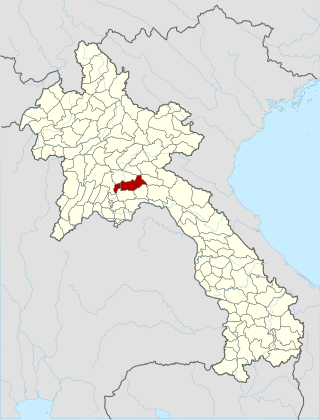
Anouvong is the capital of Xaisomboun province.

Muang Soui(In Lao: ເມືອງສຸຍ) is a small town in Xiangkhouang Province Laos. It is located on Route 7 of Laos, so east of Phoukhoune district, northwest of Phonsavan, and Ban Phou Pheung Noi, but north of Sam Thong, and Long Tieng.

Ban Phou Pheung Noi is a Laotian village located at the peak of Phou Pheung mountain in the Xieng Khouang province of Laos. Phou Pheung mountain is approximately 916 m (3,005 ft). During the Vietnam War, combat between the American allies, the Hmong, and the Pathet Lao, The Laos Marxist government, and the Communist North Vietnamese People's Army took place on the mountain. Phou Pheung mountain runs from east to west and is rocky, and is covered in tropical forests. It is south of Muang Soui - Nongtang-Nato, and west of Phou Douk, Muang Phuan, Phonsavan and Plain of Jars. To the east, about 10 miles from Ban Phou Pheung Noi, is the Num Ngum 4 hydroelectric dam.

Sam Thong is a town in Xiangkhouang province, Laos. During the Vietnam War, it was the site of a USAID refugee operation center and an administrative center for much of northern Laos.






















